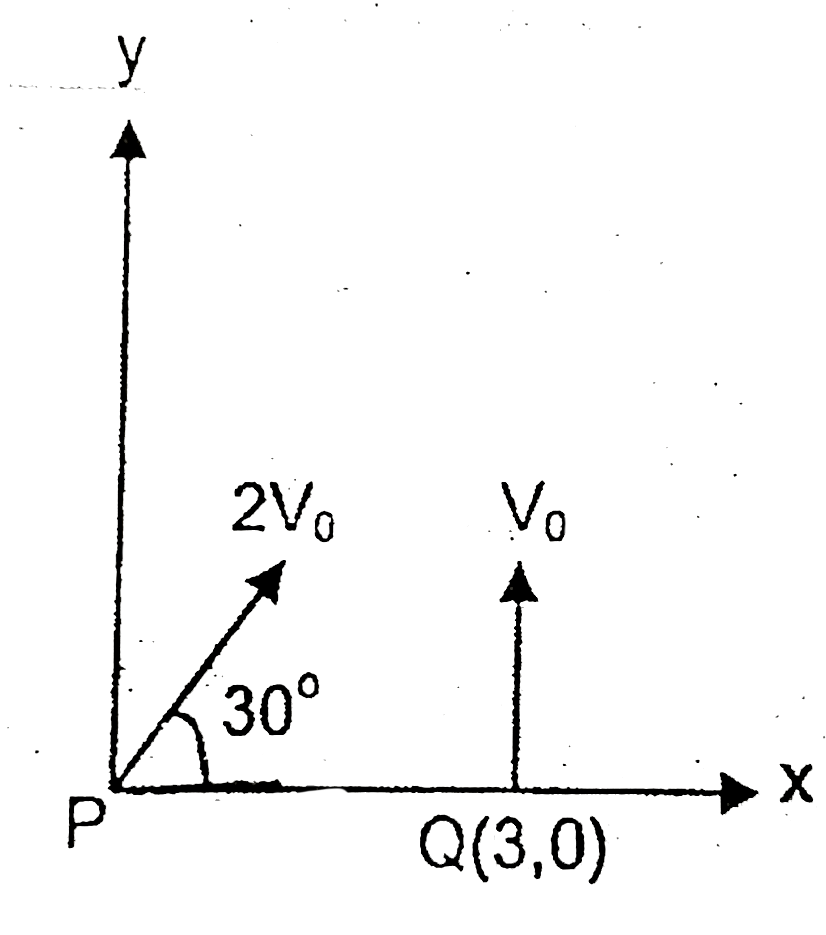Two particles P and Q are having initial velocities 2V0 and V0 respectively in horizontal x−y plane as shown in figure. P moves with constant acceleration of 5m/s2 opposite to direction of initial velocity. (V0=√103m/s). Speed of P relative to Q when they are at minimum separation is :

√10m/s
2√10m/s
√20m/s
√5m/s
The correct Answer is:C
Two particles ………….
mmotion of P with respect to Q parabolic

√3V0
x=√3V0t
y=52t2
y=x24
M is foot perpendicular draw on path of P with Q.
Let M is (X0,X204)
−2X0=X204−0(x0−3)
x0=2
So M is (2,1)
So QM is √2 meter
2=√3×√103t
t=2√10sec.
Vx=√3V0=√10m/s
Vy=5t⇒Att=2s.
Vy=√10m/s
speed =√10+10=√20m/s
Similar Questions
A particle P of charge q and m , is placed at a point in gravity free to move. Another particle Q, of same charge and mass , is projected from a distance r from P with an initial speed v_(0) towards P , initial the distance between P and Q decreases and then increases.
View SolutionTwo particles P and Q are located at the origin of a co-ordinate system.Both the particle start moving simultaneously at time t=0 .Particle P moves with a constant speed of 2 pi m/s on a circle x^(2)+y^(2)+120y=0 in clock wise direction while Q moves with a constant acceleration such that at t=5s velocities of both are same. Find :(a)The average acceleration of P during this time (b)the position vectors and velocities of particles at t=5s
View Solutionकिसी बिन्दु A से दो कण P एवं Q क्रमश: 15 मी/से एवं 20 मी/से के वेग से एक ही दिशा में अलग-अलग त्वरण से गुजर रहे हैं। जब P बिन्दु B पर Q के आगे बढ़ता है तो P का वेग होता है। बिन्दु B पर Q का वेग होगा
View Solutionकिसी बिन्दु A से दो कण P एवं Q क्रमशः 15 मी/से एवं 20 मी/से के वेग से एक ही दिशा में अलग - अलग त्वरण से गुजर रहे है। जब P बिन्दु B पर Q के आगे बढ़ता है तो P का वेग 30 मी/से होता है। बिन्दु B पर Q का वेग होगा
View SolutionTwo particles P and Q simultaneously start moving from point A with velocities 15 m//s and 20 m//s respectively. The two particles move with acceleration equal in magnitude but opposite in direction. When P overtakes Q at point B then its velocity is 30 m//s , the velocity of Q at point B will be
View SolutionThe block Q moves to the right with a constant velocity v0 as shown in figure. The relatives velocity of body P with respect to Q is ( assume all pulleys and strings are ideal)

View SolutionTwo identical balls P and Q moving in the x−y plane collide at the origin (x=0,y=0) of the coordinate system. Their velocity components just before the moment of impact were, for ball P,vx=6m/s,vy=0,p for ball Q,vx=−5m/s,vy=2m/s
As a result of the collision, the ball P comes to rest. The velocity components of the ball Q just after collision will be:
View SolutionA particle moves in xy plane such that v_(x)=50-16 t and y=100-4t^(2) where v_(x) is in m/s and y is in m. It is also known that x=0 when t=0 . Determine (i) Acceleration of particle (ii) Velocity of particle when y=0 .
View Solution
